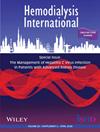Evaluation of Long-Term Effects of Parathyroidectomy in Patients With Refractory Secondary Hyperparathyroidism
Abstract
Objective
Parathyroidectomy is an effective intervention for patients with end-stage renal disease and refractory secondary hyperparathyroidism. This study aimed to assess the long-term clinical outcomes and overall quality of life of patients following parathyroidectomy in real-world clinical practice.
Methods
The study included 103 patients with refractory secondary hyperparathyroidism treated with parathyroidectomy in a real-world setting (51 males, age 58 ± 10 years). Intact parathyroid hormone (iPTH), serum calcium, and serum phosphorus indices were compared preoperatively and at 6 months, 12 months, and 1 year postoperatively. The proportion of patients with a > 30% decrease in iPTH was evaluated to assess the long-term treatment effect of parathyroidectomy. The EQ-5D-5L scale was utilized to evaluate the long-term postoperative quality of life.
Results
Fifty percent of the patients included in the study had a follow-up time of more than 19 months (19.0 [12.0, 24.0]). The median pretreatment iPTH level was 1796.2 (905.5, 2909.8) pg/mL, with 43.7% of patients exceeding 2000 pg/mL and 19.4% exceeding 3000 pg/mL; 19 (18%) patients had an iPTH level of ≤ 800 pg/mL. The preoperative mean serum calcium level was 2.54 (0.22), 95% CI (2.44, 2.68), and the mean serum phosphorus level was 2.09 (0.48), 95% CI (1.81, 2.19). Approximately 50% of patients underwent total parathyroidectomy. The iPTH levels decreased significantly after surgery (p < 0.001). At 6 months postoperatively, 96.7% of the patients had a decrease in iPTH of more than 30% compared to the preoperative levels, and this percentage was 94.9% at 12 months postoperatively. Mean serum calcium and phosphorus levels decreased significantly after surgery (p < 0.01). More than 60% of patients achieved target serum calcium levels, and more than 40% achieved target serum phosphorus levels at 6 months postoperatively, demonstrating a statistically significant increase compared to preoperative levels (p < 0.001). No significant difference in surgical outcomes was observed between the groups with preoperative iPTH levels > 800 and < 800 pg/mL. The utilization of secondary hyperparathyroidism-related medications decreased following surgical intervention. The median health utility value, as measured using the EQ-5D-5L scale, was 0.897 (0.739, 1.0), with a median VAS score of 80 (60, 90).
Conclusions
In clinical practice, parathyroidectomy demonstrates efficacy in reducing iPTH levels and facilitating the management of serum calcium and phosphorus levels. Moreover, this surgical intervention significantly decreases medication requirements and enhances the long-term quality of life for patients postoperatively. The evidence suggests that surgical intervention may confer long-term benefits to patients with refractory secondary hyperparathyroidism.

 求助内容:
求助内容: 应助结果提醒方式:
应助结果提醒方式:


